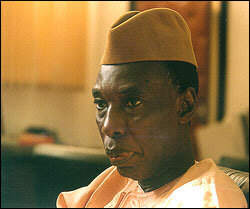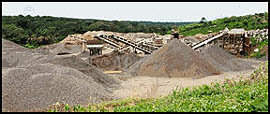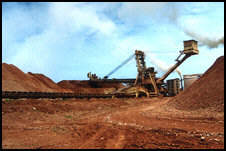 MINING UNIQUENESS MINING UNIQUENESS |
The existence of major mineral resources in Guinea was identified centuries ago. First gold was found in the treasures of Carthage in 814AD. As European colonies debarked on Guinean soil, they took an inventory of gold zones and improved traditional exploitation methods. The adoption of the first mining regulation on December 11, 1897 was the initial phase in institutionalizing the exploitation of mines. The real craze, however, didn't start until 1922, when the local government proceeded to do a general geological study of its territory in order to record the amount of its mineral riches. It was the discovery and the exploitation of diamond deposits in 1936 that increased the importance of mining in Guinea. Experts in the field estimate a total number of 25 to 30 million carats of reserves today, excluding those of Kimberlite.
The exploitation of Bauxite, of which Guinea holds one third of worlds reserves, a potential to exploit 25 billion tons per year and an AL203 grade of 45 to 60 percent, began during the the decade of the 1940's; first in Kassa, an island 5km from Conakry, and then in Badi, in lower Guinea by the river Konkoure. The consortium Pechiney conducted the exploitation in the latter region.
At the same time deposits of iron ore were being exploited by the Mining Company of Conakry. Guinea disposes of 7billion tons of iron ore reserves with a grade of up to 68%, especially near Mount Nimba.
By the time Guinea became independent on October 2, 1958, the prospecting and exploiting of gold in upper Guinea by companies such as the Mining Company of Siguiri or the Faleme-Gambian Company set Guinea's mining reputation for American and European investors. However, the young Republic, having created strong ties with the Eastern Block, met with political and economic difficulties with its partners, leaving numerous projects abandoned or simply obsolete.
It is evident that the mining sector is an essential part of the Guinean economy. The expression widely used by experts, "geological scandal", defines clearly the mining phenomenon in Guinea. Considering its size, 245 860 square kilometers, Guinea disposes of a colossal amount of reserves, not only in Bauxite, Iron Ore, in Gold, and Diamonds, but nickel, calc, silver, copper, and manganese graphite. Lastly, research by international cabinets also reveal similarities between the sedimentary layers of coastal Guinea and those that border Nigeria and Angola, suggesting the existence of the crude oil as well.

In order to allow easy investment in Guinea, the government headed by the Minister of Mines, put the Mining Center of Promotion and Investment (CPDM) into place. This agency is in charge of shortening the administrative delays necessary to obtain mining contracts and to establish an international development strategy. The newly written Mining Investment Code, whose competitiveness was underlined again during the Mining Symposium, facilitates the latter. Held in March 2000 in Conakry, the Symposium brought the representatives of the largest mining corporations together.
With aids from the World Bank and the French Agency for Development, the government was able to establish a Project for Promotion and Investment in the Mining Sector. Its mission is to draw a complete map of mineral resources at 1/200 000 out by means of geological samples, to analyze eventual constraints towards the development of the mining sector and to put trained professional and efficient executives into place. These mining policies are supported by a more attractive and incentive tax system, reinforcing the sector's role. A sector which represents almost 20% of Guinea's GDP, 80% of its exports and 29% of the states income.
As can be guessed, there is a considerable amount of mining companies that are established in Guinea at the moment. The oldest one, Friguia, is a company that transforms Bauxite to alumina. It was founded between 1957 and 1960, but only started its operations on July 2, 1973. Its partnerships include the government with 49%, and other foreign partners all regrouped under the FRIALCO umbrella, which holds 51%. After a period of 40 years, working with the technological expertise of the Pechiney Group and Alu-Suisse, Friguia, a company that produces today a total of one million tons of alumina per year was not able to be privatized as the government wished. The government therefore, bought out the shares of its partners and turned to Reynolds for a management contract. This contract has given life to a new entity: the Guinean Company of Alumina entirely managed by Alcoa, a US based Alumimium company who took over Reynolds in April 2000. Under the contract it is stated that the group will exploit the deposits around Fria for a period of at least 25 years and will introduce an investment program of 75 million dollar over a 4-year period in order to modernize the plant. Alcoa will thus produce a total of 1.2 million tons of alumina per year. The railway that connects them directly to the Autonomous Port of Conakry enables easy access to its main clients abroad.
 The Bauxite Company of Guinea: The Bauxite Company of Guinea: |

For a long time CBG's revenues represented more than half of the government's revenues and today it continues to be the main provider of foreign exchange reserves. In 1963 the Guinean Government signed a contract agreement with the HALCO consortium for the CBG establishment, becoming a anonymous company in June 1999. | Thereafter Alcom was mandated by its shareholders to supply management assistance for a five-year renewable period. The present shareholders of CBG are: the Guinean Government with 49% and a group of private investors holding 51%. The latter includes Alcoa (USA), Alcan (Canada), Pechiney (France), VAW (Germany) and COMALCO (Australia). HALCO now has the exclusive rights to extract all the bauxite from the concession extending 1,292 square kilometers from Boke to Telemele to Gaoual. CBG's operations began by exploiting the deposits in Sangaredi, Bidikoum and Silidara. Mr. Steane, General Director of CBG reminds us that in "the Sangaredi deposit the grade was plus 60% making it the richest deposit in the world." More than one sixth of alumina produced in the world originates from CBG. Today it produces 12 million tons of Alumina. These results are obtained by a permanent working force of 2600. CBG is also very much involved in socio - economic development, allowing hundreds of thousands of people living around its sites at Kamsar and Sangaredi to live off of their revenues, including educational, community, communication and sanitary services.
 The Bauxite Company in Kindia The Bauxite Company in Kindia |
Since its inception on June 21, 1970, SBK exploits the mine of Debele. At the time it cooperated with the former URSS, who supplied Guinea with technological assistance. The cooperation came into effect in 1974, but was unfortunately not profitable.

As expected in 1993 SBK defined the necessary conditions to rationalize the production and of restructuring. Initially the production capacity was of 2.5 million tons of Bauxite per year, attaining almost 3 million tons during its best years. However, in 1998 their installations were so dilapidated that its production decreased to 1.6 million tons per year.
The amount of Bauxite reserves is of 57 million tons, guarantying a minimum of 10 years of exploitation, which is internationally recognized. The objective of the General Director, Mr. Cisse, is to "find the production capacity at the required international level, to improve supplies, transport, management and continued training of personnel." Today experts estimate that with an investment of 250 million USD, SBK's activity could go on 20 years, because of the possible exploitation of the peripheral deposits that are accessible to them. SBK is one of the most important operators in terms of sustainable development in the regions of Kindia, Coya and Conakry because of its infrastructure developments.
 Aredor in Fotoba Aredor in Fotoba |
Aredor was created on March 15, 1978 by the signing of an accord between the Guinean government and Aredor for the exploitation of diamonds and gold. Between 1983 and 1994 the company produced 1 253754 carats with a value of up to 377 million dollars. In 1990 the Bidge Oil Company joined the project, but the exploitation conditions became too costly and led it shutting down in 1993. Trivalence Mining Corporation stepped in in 1996, reevaluated the reserves with the help of independent experts who found 1,351,422 exploitable carats existing on the 1200 square kilometer site. The quality of the diamonds on site is remarkable, with grades of purity oscillating from 0.35 to 0.50 carats per cubic meter. In the year 2000 two rose diamonds were found and every year one or two stones of more than 100 carats are discovered. A diamond of 18,177 carats was recently sold for 8.6 million USD. Aredor is also involved in community works such as the recent construction of a school on site, provision of free water and electricity as well as complete medical insurance.
The two major companies dealing with the exploitation of gold are the Mining Company of Dinguiraye and Ashanti Goldfieds of Guinea. The SAG is part of International Ashanti Goldfields Company originating in Ghana and managing more than 25 sites on the African continent. The group's reserves are estimated to be at 35 million ounces of gold and its turnover around 800 million dollars. Ashanti Goldfields' initial investment in Guinea in 1996 was of 170 million dollars having estimated 80 tons of gold reserves. Today they continue to make more than 1.5 million USD profits each year. The analysis in the Siguiri Mine has been of 239,218 ounces of goldwith provisions in the year 2000 close to 300,000 at a return of 185 dollars per ounce. The Guinean government holds 15% of the company which "has interests in various existing projects in Guinea in order to increase its importance and to affirm its leadership in the gold mining sector in Guinea" informed the General Director, Mr. Danso.
SMD started its operations in Guinea in 1984 when the Delta Gold Mining Company signed a protocol agreement with the Guinean Government. After six prospecting campaigns between 1984 and 1993 the production really started in 1995 with 985 kg, 1304kg in 1996, 1513kg in 1997, 2000kg in 1998 and more than 3000kg today. The gold produced at the mine has a purity of 95%. The Norwegen company KENOR posses now 85% of the SMD capital and the Guinean government 15%. |

